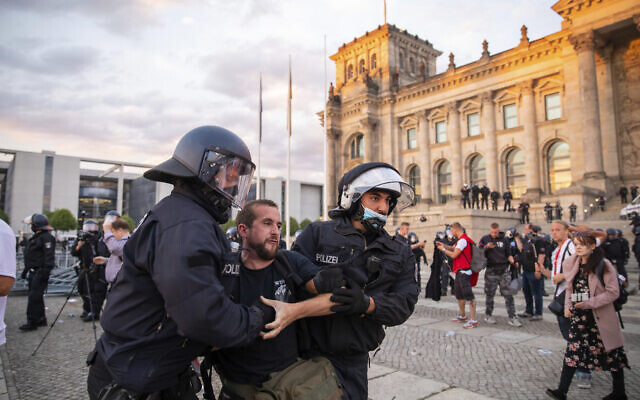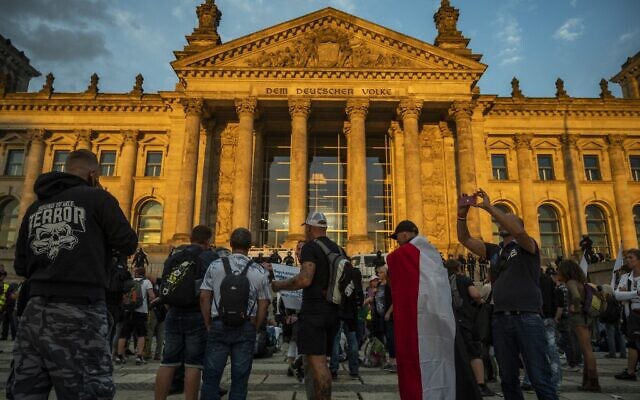German officials: Thousands of far-right extremists joined virus protest
Preliminary review finds ‘violence-prone neo-Nazis and conspiracy theorists from the so-called QAnon spectrum’ were among protesters who recently attempted to storm parliament

BERLIN (AP) — Thousands of far-right and anti-government extremists were among the crowds at demonstrations against Germany’s coronavirus restrictions last month that culminated in attempts by some protesters to storm parliament, German security officials said Wednesday.
The incident was condemned across much of the political spectrum in Germany, with the president and other senior officials describing the rush on parliament as an assault on the heart of democracy. But some lawmakers also criticized the police handling of the August 29 demonstrations and the fact that there were only a handful of officers to stand in the way of hundreds of protesters, despite advance warnings that extremists might try to enter the Reichstag.
A preliminary review of images from the protests indicated that “at least 2,500 to 3,000 right-wing extremists and Reich Citizens took part in the protests,” the head of Berlin state’s intelligence service, Michael Fischer, told lawmakers in the capital’s regional assembly.
The so-called Reich Citizens movement, which disputes the legitimacy of the post-World War II German Constitution and by extension the current government, has caused growing concern among security officials in recent years, in part due to its ties to the far right.
Fischer said those counted so far were identified as right-wing extremists based on the clothing, flags, symbols and slogans they were carrying.

He said there were “doubtless” also people in the crowd with an affinity for extremist ideologies but “who couldn’t be identified as right-wing extremists or Reich Citizens based on their outer appearance.”
Following the main rally, which police estimated drew almost 40,000 participants, up to 500 people gathered in front of the parliament building, including “violence-prone neo-Nazis and conspiracy theorists from the so-called QAnon spectrum,” Fischer said.
Fischer acknowledged that authorities received information in advance of the protests about some people calling for the storming of the Reichstag and that security officials had discussed the threat at a meeting two days before the event.
He said officials hadn’t foreseen that protesters would actually go through with the plan and called it a “spontaneous” incident.
The events of August 29 showed how compatible the positions of some of the anti-mask protesters are with those of anti-government extremists, Fischer said.
“Anybody who marches with right-wing extremists and Reich Citizens needs to realize that they are joining forces with persons and groups who want nothing less than the abolition of our liberal democratic order,” he said.










